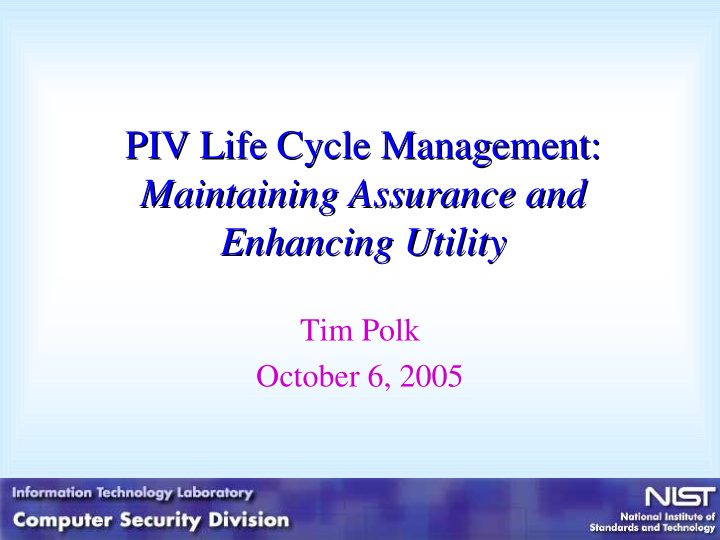



PIV Life Cycle Management: PIV Life Cycle Management: Maintaining Assurance and Maintaining Assurance and Enhancing Utility Enhancing Utility Tim Polk October 6, 2005 1
Security is More Than Technology Security is More Than Technology • Policies and procedures play a key role in a secure PIV token – just like any other security system • Things change – the system has to keep pace o People retire, change jobs, get fired o The environment changes – can the token change with it? 2
Policies and Procedures Policies and Procedures • Policies and procedures must include o Token and certificate issuance o Token and certificate revocation o Notification and changes to token holder attributes o Re-authentication and Re-issuance 3
Implementing Policies and Implementing Policies and Procedures Procedures • Personnel o Personnel in trusted roles must be trustworthy o Training o Auditing • Verifying Policies and Procedures o Compliance audits • Common PKI tool for Policy compliance • Approved by FPKI Policy Authority o Certification and Accreditation • Agency DAA signs off on system 4
Emergency Notification Emergency Notification • Emergency notification procedures must be established for each agency • Triggers: o Employee or contractor separation o Assurance decreased o Token lost or compromised 5
When are emergencies noticed? When are emergencies noticed? • Separation o Usually known to government or the employer, but who tells the token issuer and certificate issuer? • Loss or compromise o Do token holders know their responsibilities? 6
Emergency Response Emergency Response • Token Revocation • Token Status Registry Updates • Certificate Management Issues 7
Directory Management Directory Management • Directory architecture reflects local versus global data o If all data is global • Then a single publicly accessible directory is sufficient o If some data is local, two solutions: • Internal and border directories • Authenticated access to controlled attributes 8
OCSP Responder OCSP Responder • Essentially, two configurations: o CRL driven o CA database driven • For CRL driven responders, updating the LDAP directory is a complete solution • Where the CA database drives the OCSP responder, secure connections between CA and OCSP responder are required 9
So, FIPS 201 Will Establish… So, FIPS 201 Will Establish… • Policy and procedural requirements to ensure token management and personnel management are tightly coupled • Policy and mechanism requirements to ensure token status information is accurate and available • C&A and training requirements to ensure procedures are implemented correctly 10
Adapting to Environment Adapting to Environment • The PIV token needs to be adaptable to reflect changes in environment o Every agency is different o Every agency evolves • FIPS 201 will specify a minimum set of functionality o Additional functions may be added to meet agency requirements 11
Recommend
More recommend